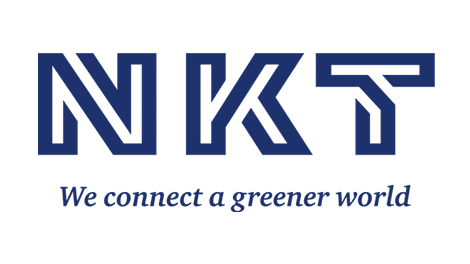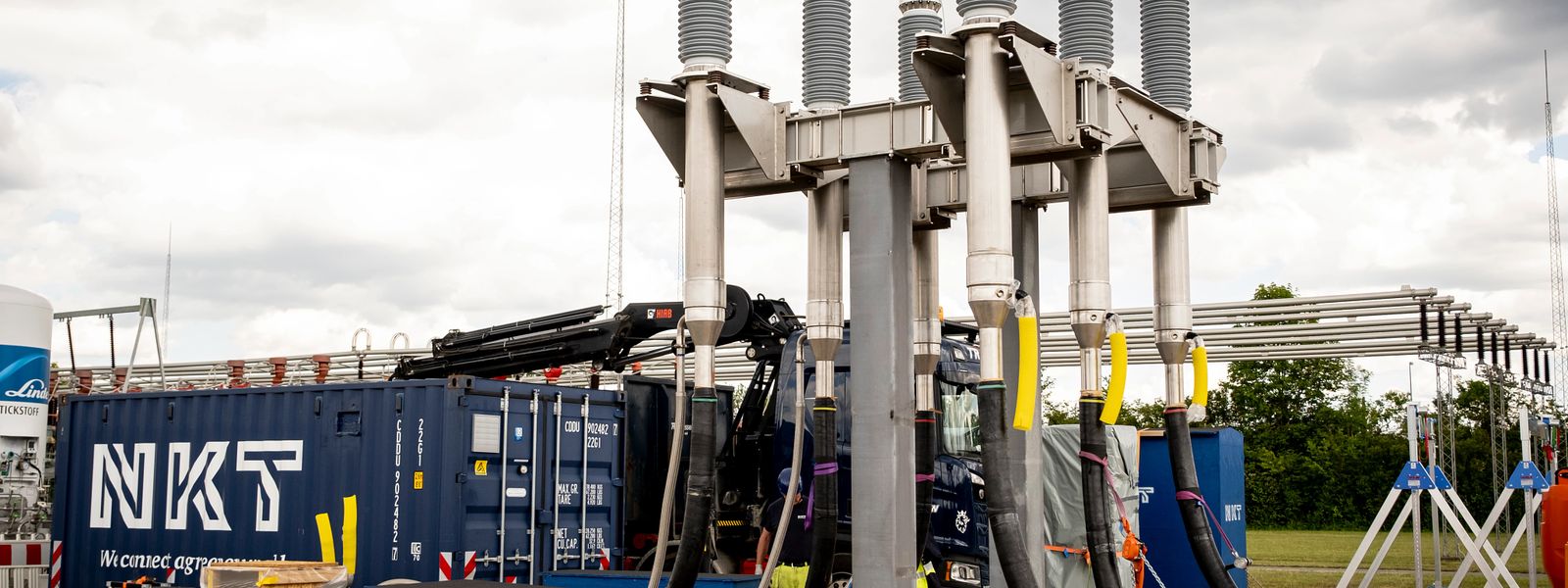NKT – NKT powers up test system for the world’s longest superconducting power cable
NKT, Stadtwerke München Infrastruktur, and other partners have inaugurated the test system of the world’s longest superconducting power cable system, SuperLink, in Munich, Germany.
With the switch turned on, power is now running through the superconducting power cable test system as part of the development of the 110 kV SuperLink – the world’s longest superconducting power cable. This milestone has been achieved through an innovative design process, continuous testing, and strong collaboration between project owner Stadtwerke München Infrastruktur, a subsidiary of the utility Stadtwerke München, and project partners, with NKT developing the innovative solution.
– The SuperLink project represents true innovation, where we are exploring new, exciting frontiers to leverage the potential of superconducting power cable technology at unprecedented voltage levels. We appreciate the collaboration with Stadtwerke München Infrastruktur and the other partners leading to the inauguration of the test system. This is an important pilot project demonstrating the potential of superconducting technology for optimized access to renewable energy in larger cities such as Munich, says Anders Jensen, Chief Technology Officer at NKT.
SuperLink is a forward-looking project, and once the ongoing tests are completed and the project is tendered, it is expected to become a 15-kilometer underground power link, making it the longest superconducting power cable solution globally.
Superconductors to meet global challenges
With 1.5 million residents, Munich is an ideal city to develop and live-test the possibilities of superconducting power cables for expanding power grids in urban areas. Large cities worldwide face similar challenges, with growing populations driving an increasing demand for renewable electricity, which strains the capacity of existing power grids.
– We plan to construct a 15-kilometre high-voltage line between the main substation in Menzing and the southern energy site in Sendling. This innovative line will enhance the sustainability and climate-friendliness of SWM Infrastruktur’s power grid. Moreover, it will contribute to making power grids more efficient, stable, and climate-friendly beyond Munich’s city limits, says Helge-Uve Braun, Technical Managing Director in Stadtwerke München
SuperLink is customized to the needs of Stadtwerke München Infrastruktur, providing a unique opportunity to showcase the viability of the technology in addressing increasing grid congestion driven by urbanization, increased electrification, and more renewable energy entering the energy mix. Superconducting power cables are extremely compact compared to conventional cable technology and can become a key enabler of the transition to renewable energy in urban areas due to their high power-to-size ratio.
Facts: SuperLink
SuperLink is an innovative superconducting power cable system designed for power-dense transmission, enabling the transfer of large amounts of electric power through a compact cable design.
- Testing phase: The ongoing tests of the superconducting power cable system are expected to be completed in Q2 2025.
- Specifications: SuperLink will span 15 kilometers, with a power rating of 500 MW and a voltage level of 110 kV.
- Installation: To minimize construction work, SuperLink will be installed in very compact ducts.
- Location: This system will deliver substantial power through a narrow corridor in the heart of Munich.
- Cooling System: The superconducting cable will be cooled to -200ºC using environmentally harmless nitrogen in a closed circuit. A cooling system with redundant back-up coolers will be an integral part of the setup.
SourceNKT
EMR Analysis
More information on NKT: See the full profile on EMR Executive Services
More information on Claes Westerlind (President and Chief Executive Officer, NKT): See the full profile on EMR Executive Services
More information on Anders Jensen (Members of the Global Leadership Team, Chief Technology Officer, NKT): See the full profile on EMR Executive Services
More information on Stadtwerke München (SWM): https://www.swm.de/english + Stadtwerke München (SWM), Munich’s municipal utilities company, is one of the largest energy and infrastructure companies in Germany. SWM supplies Munich 24/7 with energy (electricity, natural gas, district heating/cooling), fresh drinking water, mobility and advanced, cutting-edge telecommunication services. Sustainability and climate protection are essential cornerstones of our corporate policy in all sectors.
More information on Dr. Florian Bieberbach (Chairman of the Management Board, Stadtwerke München (SWM)): https://www.swm.de/unternehmen/stadtwerke-muenchen + https://www.linkedin.com/in/florian-bieberbach/
More information on Helge-Uve Braun (Technical Managing Director, Stadtwerke München (SWM)): https://www.swm.de/unternehmen/stadtwerke-muenchen
More information on Stadtwerke München Infrastruktur by SMW: https://www.swm-infrastruktur.de/ + Operator of the local energy supply network. We are the partner for municipal energy supply for cities and municipalities
More information on Stefan Dworschak (Managing Director, Stadtwerke München Infrastruktur, SMW): https://www.swmhttps://www.swm-infrastruktur.de/info/impressum + https://www.linkedin.com/in/stefan-dworschak-b84634280/
EMR Additional Notes:
- Power Cable:
- A power cable is a type of electrical cable used to transmit electrical power. It typically consists of one or more insulated conductors surrounded by a protective outer sheath.
- Types of power cables:
- Overhead cables: These are suspended from poles or towers and are commonly used for long-distance power transmission.
- Underground cables: These are installed underground and are typically used for local distribution or in areas where overhead lines are impractical or unsafe.
- Submarine cables: These are laid underwater to connect islands, countries, or offshore wind farms to the mainland power grid.
- Medium-voltage cables: These are used for the distribution of electrical power from substations to local areas.
- Low-voltage cables: These are used for the final distribution of power to individual homes and businesses.
- Superconducting Power Cable:
- A superconducting power cable is a type of electrical cable that uses superconducting materials to conduct electricity with zero resistance. This means that no energy is lost due to heat dissipation, making it significantly more efficient than traditional copper or aluminum cables. Superconducting cables can be used to transmit large amounts of power over long distances with minimal energy losses.
- Extra Low-Voltage (ELV):
- Voltage of 50V or less (AC RMS), or 120V or less (ripple-free DC).
- Low-Voltage (LV):
- The International Electrotechnical Commission (IEC) defines supply system low voltage as voltage in the range 50–1000 V AC or 120–1500 V DC.
- Medium-Voltage (MV):
- Medium-voltage circuit breakers rated between 1 and 35/72 kV.
- High-Voltage (HV):
- The International Electrotechnical Commission define high voltage as above 1000 V for alternating current, and at least 1500 V for direct current.
- Super High-Voltage or Extra High-Voltage (EHV):
- Is >300kV.
- Ultra High-Voltage (UHV):
- Is >1.000kV.
- Kilovolt-Amperes (kV):
- Kilovolt or “kV” means a unit of potential difference equal to 1,000 volts. Kilovolt or “kV” means the potential difference between two points on a conductor carrying a current of one ampere when the power dissipated between the two points is one kilovolt-ampere. Kilovolt means one thousand volts (kV).
- Kilovolt (kVA):
- kVA stands for Kilo-volt-amperes – a term used for the rating of an electrical circuit. kVA is the product of the circuits maximum current and voltage rating. It is also known as Apparent Power.
- kW is the unit of real power and kVA is a unit of apparent power (or real power plus re-active power). The power factor, unless it is defined and known, is therefore an approximate value (typically 0.8), and the kVA value will always be higher than the value for kW.
- A kVA is 1,000 volt-amps. It’s what you get when you multiply the voltage (the force that moves electrons around a circuit) by the amps (electrical current).
- Megavolt-Amperes (MVA):
- MVA or megavolt-amperes is the unit used to measure the apparent power in a circuit. It’s a product of the voltage and current in a circuit.
- 1 kVA is equivalent to 1,000 volts while the 1 MVA is equivalent to 1,000,000 volt-amperes.
- Grid, Microgrids, DERs and DERM’s:
- The power grid is a network for delivering electricity to consumers. The power grid includes generator stations, transmission lines and towers, and individual consumer distribution lines.
- The grid constantly balances the supply and demand for the energy that powers everything from industry to household appliances.
- Electric grids perform three major functions: power generation, transmission, and distribution.
- A microgrid is a small-scale power grid that can operate independently or collaboratively with other small power grids. The practice of using microgrids is known as distributed, dispersed, decentralized, district or embedded energy production.
- Smart Grid is any electrical grid + IT at all levels . Micro Grid is a group of interconnected loads and DERs (Distributed energy resources) within a clearly defined electrical and geographical boundaries witch acts as a single controllable entity with respect to the main grid.
- Distributed energy resources (DERs) are small-scale electricity supply (typically in the range of 3 kW to 50 MW) or demand resources that are interconnected to the electric grid. They are power generation resources and are usually located close to load centers, and can be used individually or in aggregate to provide value to the grid.
- Common examples of DERs include rooftop solar PV units, natural gas turbines, microturbines, wind turbines, biomass generators, fuel cells, tri-generation units, battery storage, electric vehicles (EV) and EV chargers, and demand response applications.
- Distributed energy resources management systems (DERMS) are platforms which helps mostly distribution system operators (DSO) manage their grids that are mainly based on distributed energy resources (DER).
- DERMS are used by utilities and other energy companies to aggregate a large energy load for participation in the demand response market. DERMS can be defined in many ways, depending on the use case and underlying energy asset.


